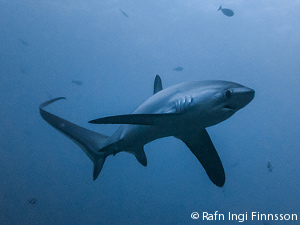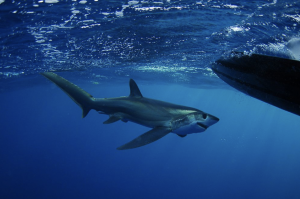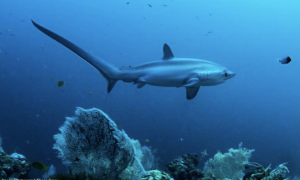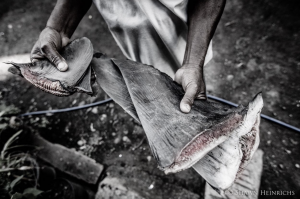
In this blog post, we are going to have a closer look at Thresher sharks as a species, and learn about what makes them unique, their habitat, life cycles, and threats. A lot is still very unknown about Thresher sharks. There is a lack of data regarding critical habitat, population numbers, and reproductive trends, which makes conservation and management of this species particularly challenging.
With their distinctly large and unique tail fins, Thresher sharks are not hard to identify amongst other shark species. Their Caudal fins ( tail fins ) are sometimes as long as their entire body and are used to hunt prey in a method that is very different from other shark species. Other unique identification features of Thresher sharks include big eyes, large and pointed pectoral fins and a small mouth and teeth. FUN FACT – Thresher sharks have been known to leap out of the water!
Thresher sharks are large sharks in the Alopiidae family. There are three species of Thresher sharks – Common thresher shark, Pelagic thresher shark, and Bigeye Thresher shark. All three species are mostly found in warm and temperature waters around the world. Whilst they prefer the more offshore and deeper pelagic regions of the oceans, they have been known to venture into coastal areas in pursuit of food. The three species of Threshers can be quite hard to tell apart as they all have quite similar species. Amongst the three, the Pelagic Thresher and the Big Eye Thresher are the most similar.
Common Thresher Shark ( Alopias vulpinus )
The Common Thresher is the most common. Common Thresher sharks can be found in temperate waters around the world. There have been high population numbers recorded of Common Thresher sharks in the Atlantic Ocean. They are the largest of the three species and can reach sizes of up to 6.5m in length. The common thresher can be distinguished by the white band that extends from the belly over the pectoral fins, which is unique to this species. This species is very vulnerable to fisheries exploitation, both target, and by-catch because its habitat is within the ranges of many unregulated and underreported commercial fisheries.

Big Eye Thresher Shark ( Alopias superciliosus )
Big Eye Thresher sharks can be found in subtropical ocean regions around the world, ranging from oceanic to coastal, shallow to water to depths around 500m. They have been found in Indonesian waters, but little is known about their migratory patterns. Big Eye Threshers sharks grow up to an average of 3-4 meters in length. Compared to the other two species of Thresher sharks, Big Eye threshers have uniquely large eyes ( hence the name ). Their eyes tend to be taller than it is wide and bulges out. This feature is likely an adaption for hunting in low light deeper waters. Because they are a deeper species, they are considered less ‘catchable’ than the other two thresher shark species ( IUCN, 2018 ).

Pelagic Thresher Shark (Alopias pelagicus)
This is the smallest of the three species, averaging at around 3m in length. Pelagic threshers are most often found in the open ocean in depths ranging from the surface to 150m, but they are also known to come close to shore especially in areas where the continental shelf is not very wide and comes closer to shore. This species is particularly vulnerable to fisheries exploitation, both target, and by-catch because its habitat is within the ranges of many gill net and longline fisheries. In Alor, Indonesia, where our Thresher Project is based, the Pelagic Thresher shark is the target of small scale artisanal fisheries. In the indo-pacific and the South China Sea, it is estimated that the population has declined by over 80% in the last ten years.

HUNTING BEHAVIOUR
Thresher sharks use their large caudal fin ( tail ) as a weapon to stun and kill their prey. To do this, the shark will accelerate towards its prey, then abruptly stop, facing downwards, using their large pectoral fins. This movement catapults their tail over their body at an extremely fast speed which then hits their prey stunning and killing them. This hunting method is unique to Thresher sharks. Their diet mainly consists of small fish.
Click this YOUTUBE link below to watch a video of a thresher shark hunting .
LIFE CYCLE
Thresher sharks are slow to mature and have a low reproductive rate. They reach sexual maturity between 8 – 14 years of age and typically have a small number of pups. These slow life history traits mean a low capacity to recover from overexploitation by fisheries.

THREATS
Bycatch, overfishing by both commercial and artisanal fisheries, and the demand for shark fins are the driving forces behind the continued exploitation of this species. In Indonesia, Thresher sharks are amongst the most regularly landed shark species based on the national statistic from 2002-2014 ( Indonesian Ministry of Marine and Fisheries ). Thresher sharks are most commonly caught as bycatch by driftnet, gillnet, and longline fisheries.

CONSERVATION STATUS
Thresher Sharks are listed on CITES Appendix II – which means that the international trade of the species is regulated. Pelagic Thresher sharks are listed is ENDANGERED on the IUCN Red List. In Indonesia, Thresher sharks are also protected under the Indian Ocean Tuna Commission ( IOTC ) in association with fisheries in certain areas of competence. The population decline of this species is a result of their slow life characteristics and high levels of unmanaged and unreported catch rates of this species as both target and bycatch in fisheries.